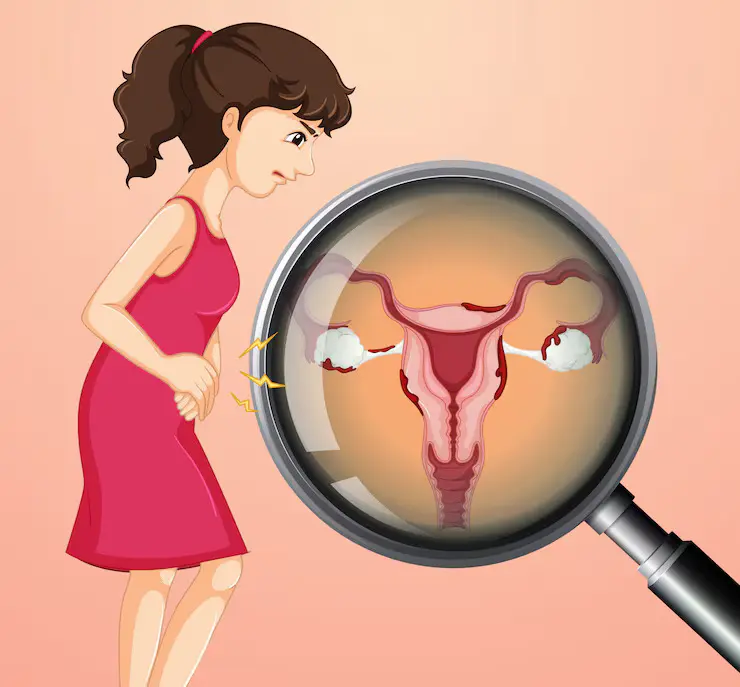Period pain is something many people experience—but when the pain becomes unbearable, lasts for days, or interferes with daily life, it could be a sign of something more serious: endometriosis.
In this article, we'll break down what endometriosis is, how it causes chronic period pain, and what you can do about it.
What is Endometriosis?
Endometriosis is a chronic condition in which tissue similar to the lining of the uterus (called the endometrium) grows outside of the uterus. This tissue can attach to the ovaries, fallopian tubes, the outer surface of the uterus, and even organs in the pelvic cavity.
Even though this tissue is outside the uterus, it behaves just like the uterine lining—it thickens, breaks down, and bleeds with each menstrual cycle. But unlike a regular period, the blood from this misplaced tissue has nowhere to go. This leads to inflammation, pain, scar tissue, and sometimes even fertility issues.

Signs and Symptoms of Endometriosis
The most common symptom is chronic pelvic pain, especially during your period. But it can also show up in other ways:
- Severe period cramps that worsen over time
- Pain during or after sex
- Painful bowel movements or urination, especially during menstruation
- Heavy menstrual bleeding or bleeding between periods
- Chronic lower back or abdominal pain
- Fatigue, nausea, or bloating
- Infertility (difficulty getting pregnant)
If your period pain is so intense that it's disrupting your everyday life, it's worth talking to a healthcare provider.
Why Does Endometriosis Cause Chronic Period Pain?
The pain from endometriosis is caused by several overlapping issues:
- Inflammation: The bleeding of endometrial-like tissue in places it shouldn’t be causes irritation and inflammation.
- Scar tissue and adhesions: As your body tries to heal the inflammation, it forms scar tissue, which can cause organs to stick together.
- Nerve involvement: Endometriosis lesions can irritate or grow near nerves, amplifying pain signals.
- Hormonal fluctuations: Estrogen tends to “feed” endometriosis, which is why symptoms often flare during the menstrual cycle.
How Is Endometriosis Diagnosed?
Unfortunately, endometriosis is notoriously difficult to diagnose. Many people go years—sometimes even a decade—before getting a clear answer.
Steps toward diagnosis include:
- Symptom tracking: Keeping a diary of your period pain and related symptoms
- Pelvic exam: A doctor may feel for cysts or scars behind the uterus
- Ultrasound or MRI: To identify cysts (like endometriomas), though smaller lesions are hard to see
- Laparoscopy: A minor surgical procedure that allows doctors to look inside the abdomen and confirm endometriosis. This is the only definitive diagnosis.
Treatment Options for Endometriosis
There’s no cure for endometriosis, but there are several treatments that can help manage pain and improve quality of life:
1. Pain Management
- Over-the-counter (OTC) medications such as ibuprofen or naproxen can reduce inflammation and relieve mild to moderate pain.
- For more severe pain, doctors may prescribe stronger medications if OTC options are not effective.
2. Hormonal Treatments
Hormone therapy can help slow the growth of endometrial-like tissue and reduce or stop menstruation.
- Birth control pills, patches, or vaginal rings
- Progestin-only treatments like hormonal IUDs, pills, or injections
- GnRH agonists and antagonists – These reduce estrogen levels, putting the body in a temporary menopause-like state to relieve symptoms.
3. Surgical Options
Surgery may be recommended for those who do not respond to medication or have more severe cases.
- Laparoscopic surgery: A minimally invasive procedure to remove or destroy endometrial implants and scar tissue.
- Hysterectomy: In extreme cases, removal of the uterus (and sometimes ovaries) may be considered when other treatments fail and pregnancy is not a future plan.
4. Lifestyle and Supportive Care
Holistic care and lifestyle changes can help support medical treatment:
- Anti-inflammatory diet (rich in whole foods, low in processed sugar and red meat)
- Regular exercise, which may help relieve pain and reduce inflammation
- Acupuncture, pelvic floor therapy, or physical therapy
- Mental health support through counseling or support groups, which can be crucial for managing chronic pain and emotional stress
Endometriosis and Fertility
Endometriosis can affect fertility in up to 30-50% of people with the condition. The good news? Many go on to have successful pregnancies with or without fertility treatment. If you're trying to conceive and have endometriosis, working with a fertility specialist is often the best route.
When Should You Talk to a Doctor?
If your period pain:
- Prevents you from going to school, work, or daily activities
- Doesn’t improve with over-the-counter medication
- Comes with other symptoms like pain during sex or digestion issues
- Has been ongoing for months or years
…it’s time to speak up. You deserve answers—and relief.
Final Thoughts
Living with endometriosis can be exhausting, but you’re not alone—and you’re not imagining your pain. Getting a diagnosis can be the first step toward regaining control over your body and your life. With the right care and support, you can manage your symptoms and live well.